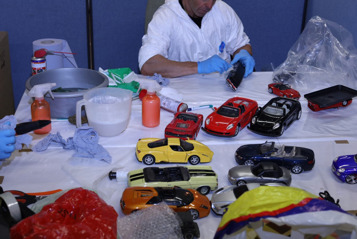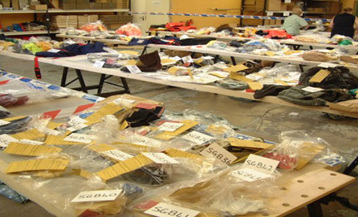By Victoria Baker, Account Manager and Kenyon Responder
The importance of personal effects in the aftermath of mass fatality incidents cannot be understated. They are often the last thing that a loved one touched before the incident, and for most, represent a tangible connection to a loved one in their final moments.
In the rare case that the remains of a loved one cannot be recovered, these items carry the burden of replacing ceremonial goodbyes. In a more practical sense, they can also serve as a confirmation of a person’s involvement in an incident, particularly when a family member is having trouble comprehending the sudden loss. Personal effects can also assist in the identification process. Following mass fatality incidents, the Disaster Victim Identification (DVI) process relies on established forensic methods, including DNA analysis, dental records, and fingerprinting. Some personal effects, in particular any identification that a person may carry, can give a reliable initial indication as to the identity of the deceased person. ID cards, passports and bank cards come to mind first, but jewellery items often carry engravings of the names of loved ones, or significant dates, that can help not only associate an item with an individual, but also identify the human remains to which they are attached.
No one in our industry would dispute the above but I’m not here to tell you anything you already know. Rather, I’d like to explain the processes that encompass a good personal effects response. Each response comes with its own intricacies and nuances which no article could ever hope to cover, but my hope is that I can demystify the process and explain the importance of our methods.

Since Kenyon’s inception in 1906, we have been providing personal effects processing and return for families who have lost loved ones to mass fatality incidents. Our first response of this kind was a train derailment in Salisbury, UK, which killed 28 people, including 5 from the USA, who needed, along with their personal effects, to be repatriated back home. Since then, we have repeated the process hundreds of times, in our warehouses, at the scene, or on our client’s premises, with the final goal being to return items to the families, in the condition they request, in the most respectful and timely way possible. Not all the below procedures are always completed by Kenyon, but we could provide this service end to end if the situation demands, for example, the scene is inaccessible or overwhelming for emergency departments, or the scene is released to us by the authorities.
The process begins with the documentation of the scene. Personal effects and human remains are forensically tagged, photographed, and their location recorded. Just like at a crime scene, these items could be potential evidence, and removing them without following strict procedures could prove catastrophic for an investigation. Personal effects may also be collected at the mortuary, where items associated with remains will be kept intact until an identification can be ascertained. Items are then bagged in evidence bags, labelled, sealed, protected, and transferred to our warehouses, or the location allocated for processing, where our staff formally take receipt of them. A chain of custody log is kept throughout movements, to ensure the integrity of the effects, and in most cases, the Kenyon staff charged with collection of personal effects will be the ones packaging and accompanying them back to the processing facility.
Once back at the facility, personal effects are dried, on purpose built drying racks, and, if necessary, decontaminated. They are then inventoried again and assigned a unique reference number (URN). We photograph the items in our professional studio set up, and upload these to a database, where the items are categorised and described. Any items that are easily attributed to an individual are known as ‘Associated’ items, and these are kept separately, and the families are contacted to start the return process.

Aviation family assistance legislation dictates that the family members must be included in the decisions regarding the final disposition of any items that they may have a claim to. We contact the families at the beginning of the process to ascertain whether they would like to be included in the process. If they say no, there will be no further contact, but the company may choose to keep and store all items in case that family changes their minds, which, from past experience, happens in a lot of cases. Once these wishes have been gathered, we provide the families with a catalogue of unassociated personal effects from which they can identify their own items. Claims are submitted to Kenyon to review and, if necessary, verify ownership. The families are asked to confirm their wishes for the return of their items: the condition they would like them in and how they would like them sent. Families are given the option to receive personal effects as they were recovered, cleaned, or restored. Our personal effects experts then clean and restore the effects accordingly, using a range of cleaning and restoration techniques honed over many years. All items are then carefully packaged, whether that be jewellery boxes, or protective wrapping, and either shipped or hand delivered to family members, depending on their wishes. Our responders carry out checks on the process for quality control at regular intervals.
When the process is complete, and all personal effects that need to be returned have been, the final step is to either store or securely destroy the remaining items. Worldwide legislation usually dictates the requirement for the items still to be accessible at least 18 months following the event, but many companies choose to store them for longer periods of time, in case any family members change their minds. There are also legal bases in which items need to remain accessible, for example, if a next of kin is a minor at the point of incident. In that case, all items will need to be stored until the time at which the items can be legally claimed. Subsequent secure destruction is undertaken with a professional company, and we receive a certificate of destruction to confirm the process is complete.
We have provided this service in many different conditions, from clients’ own premises to airport lounges, temporary buildings, and our own warehouses. We have previously provided support for aviation incidents, both fatal and non-fatal, building fires with over 100 apartments, terrorist incidents, as well as smaller scale operations, including single fatality incidents, or single item jewellery restoration. We never know what an item will mean to a family member and so we treat everything we recover with the exact same care and attention, whether that be expensive jewellery or items that are clearly sentimental, or everyday items, like scribbled notes, shopping lists, and receipts; any item can be priceless.
To find out more about real life experiences with recovery and return of personal effects view our case studies or to learn more about our personal effects service, part of our Disaster Recovery Services, speak to our emergency planning experts at kenyon@kenyoninternational.com or +1 281 872 6074 / +44 1344 316 650.
